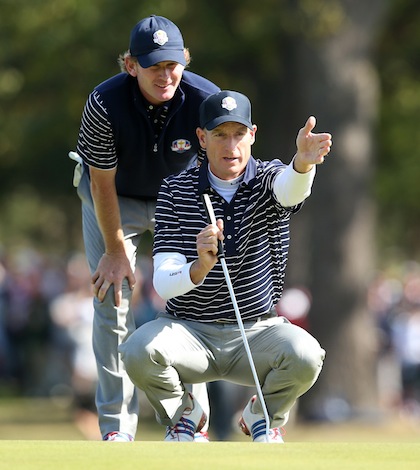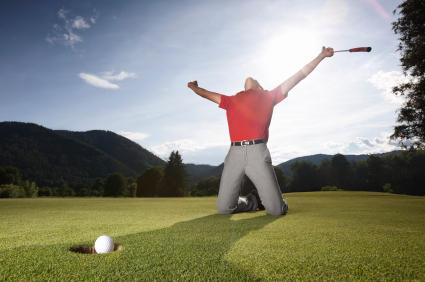Instruction
Think, then play

This may seem like a really stupid question, but stay with me here: What is the goal of a competitive game of golf?
Reasons for participating may include:
- I want to get out with friends/family.
- I want to get out of mowing the lawn.
- I like to get outside and exercise.
- I’m addicted!
- I have a challenge I have set myself and I need to reach it.
- I conduct a lot of business out on the course.
- It’s my career.
- I want to let off some steam!
But I am sure that past all of these, the goal of the competitive game of golf is “to get the little white ball into the slightly larger hole, in the minimum number of shots.” I think a useful idea for many golfers would be to go out and play with this in mind!
The swing is one hugely important part of the equation of playing great golf. But unfortunately that is it; it is just one part and not the only thing that needs attention when trying to lower your score.
Let’s say you are a professional caddy working with a player in a competition. Depending on the player you work with, you may be expected to help out with club selection, assessing the lie of the ball, suggesting the most worthwhile area of the fairway/green to aim for, fitting a game plan to a player’s particular strengths, checking the wind, slope, humidity and a whole host of other things which may affect the ball flight. You will often be expected to be aware of normal carry distances of the selected club and then be able to compute all of this to help the player come up with the best plan to play the shot at hand. As a caddy, your attention must be on almost everything, apart from manufacturing the swing; that is the player’s job after all!
Well, if we step back into reality for the majority of golfers, you are not privileged enough to have a caddy to help you make these decisions and instead you must make them yourself.
Unfortunately, many of these decisions are never made, as the attention is instead placed solely on “how to swing the club.”
While spending time with some of my players on the course, I observe a lot of other golfers playing. What I have seen often is lots of attention on swing technique at the expense of attention to all of the other factors, which may have as much or more impact on their score. It is invariably too late to make major technical changes when you’re on the course you will see why this is not the best strategy.
Instead, take note of what Tiger Woods says about often having to battle hard and win with what he describes as his “B” or “C” game. When he is striking the ball less than perfect, he makes sure that through sharp decision making and management of his golf ball, he can still compete and score well by calculating his risks and playing with the golf swing he has turned up with that day.
If this doesn’t seem to make sense, think about another sport. Take a basketball player about to attempt a three-pointer and have him think solely about his technique. Without a clear look at the target and being aware of what trajectory he needs to both make the shot and avoid those attempting to block it, I think you will agree that the likelihood of him making the shot decrease. The whole picture needs to be considered to give the highest possible chance of success.
A “perfect” golf swing and “pure” strike that goes straight at the target are of little value if you have gone for a sucker-pin and go even just a few yards too long.
Next time you play, I suggest spending time in what is often called the”‘think box” prior to the shot. Here, golfers decide the best way to play the shot at hand and never allow themselves more than one one swing thought for the shot they will play.
Then, once all the decisions have been made, step out of this box, get over the golf ball and step into the “play box.” As the name suggests, PLAY GOLF!
- LIKE1
- LEGIT1
- WOW1
- LOL1
- IDHT1
- FLOP1
- OB1
- SHANK1
Instruction
Clement: Laid-off or perfect fade? Across-the-line or perfect draw?

Some call the image on the left laid off, but if you are hitting a fade, this could be a perfect backswing for it! Same for across the line for a draw! Stop racking your brain with perceived mistakes and simply match backswing to shot shape!
- LIKE0
- LEGIT0
- WOW0
- LOL0
- IDHT0
- FLOP0
- OB0
- SHANK1
Instruction
The Wedge Guy: The easiest-to-learn golf basic

My golf learning began with this simple fact – if you don’t have a fundamentally sound hold on the golf club, it is practically impossible for your body to execute a fundamentally sound golf swing. I’m still a big believer that the golf swing is much easier to execute if you begin with the proper hold on the club.
As you might imagine, I come into contact with hundreds of golfers of all skill levels. And it is very rare to see a good player with a bad hold on the golf club. There are some exceptions, for sure, but they are very few and very far between, and they typically have beat so many balls with their poor grip that they’ve found a way to work around it.
The reality of biophysics is that the body moves only in certain ways – and the particulars of the way you hold the golf club can totally prevent a sound swing motion that allows the club to release properly through the impact zone. The wonderful thing is that anyone can learn how to put a fundamentally sound hold on the golf club, and you can practice it anywhere your hands are not otherwise engaged, like watching TV or just sitting and relaxing.
Whether you prefer an overlap, interlock or full-finger (not baseball!) grip on the club, the same fundamentals apply. Here are the major grip faults I see most often, in the order of the frequency:
Mis-aligned hands
By this I mean that the palms of the two hands are not parallel to each other. Too many golfers have a weak left hand and strong right, or vice versa. The easiest way to learn how to hold the club with your palms aligned properly is to grip a plain wooden ruler or yardstick. It forces the hands to align properly and shows you how that feels. If you grip and re-grip a yardstick several times, then grip a club, you’ll see that the learning curve is almost immediate.
The position of the grip in the upper/left hand
I also observe many golfers who have the butt of the grip too far into the heel pad of the upper hand (the left hand for right-handed players). It’s amazing how much easier it is to release the club through the ball if even 1/4-1/2″ of the butt is beyond the left heel pad. Try this yourself to see what I mean. Swing the club freely with just your left hand and notice the difference in its release from when you hold it at the end of the grip, versus gripping down even a half inch.
To help you really understand how this works, go to the range and hit shots with your five-iron gripped down a full inch to make the club the same length as your seven-iron. You will probably see an amazing shot shape difference, and likely not see as much distance loss as you would expect.
Too much lower (right) hand on the club
It seems like almost all golfers of 8-10 handicap or higher have the club too far into the palm of the lower hand, because that feels “good” if you are trying to control the path of the clubhead to the ball. But the golf swing is not an effort to hit at the ball – it is a swing of the club. The proper hold on the club has the grip underneath the pad at the base of the fingers. This will likely feel “weak” to you — like you cannot control the club like that. EXACTLY. You should not be trying to control the club with your lower/master hand.
Gripping too tightly
Nearly all golfers hold the club too tightly, which tenses up the forearms and prevents a proper release of the club through impact. In order for the club to move back and through properly, you must feel that the club is controlled by the last three fingers of the upper hand, and the middle two fingers of the lower hand. If you engage your thumbs and forefingers in “holding” the club, the result will almost always be a grip that is too tight. Try this for yourself. Hold the club in your upper hand only, and squeeze firmly with just the last three fingers, with the forefinger and thumb off the club entirely. You have good control, but your forearms are not tense. Then begin to squeeze down with your thumb and forefinger and observe the tensing of the entire forearm. This is the way we are made, so the key to preventing tenseness in the arms is to hold the club very lightly with the “pinchers” — the thumbs and forefingers.
So, those are what I believe are the four fundamentals of a good grip. Anyone can learn them in their home or office very quickly. There is no easier way to improve your ball striking consistency and add distance than giving more attention to the way you hold the golf club.
More from the Wedge Guy
- The Wedge Guy: Golf mastery begins with your wedge game
- The Wedge Guy: Why golf is 20 times harder than brain surgery
- The Wedge Guy: Musings on the golf ball rollback
- LIKE88
- LEGIT14
- WOW6
- LOL1
- IDHT0
- FLOP4
- OB1
- SHANK8
Instruction
Clement: Stop ripping off your swing with this drill!

Not the dreaded headcover under the armpit drill! As if your body is defective and can’t function by itself! Have you seen how incredible the human machine is with all the incredible feats of agility all kinds of athletes are accomplishing? You think your body is so defective (the good Lord is laughing his head off at you) that it needs a headcover tucked under the armpit so you can swing like T-Rex?
- LIKE0
- LEGIT3
- WOW2
- LOL0
- IDHT0
- FLOP0
- OB0
- SHANK2
-

 19th Hole2 weeks ago
19th Hole2 weeks agoJustin Thomas on the equipment choice of Scottie Scheffler that he thinks is ‘weird’
-

 19th Hole2 weeks ago
19th Hole2 weeks ago‘Absolutely crazy’ – Major champ lays into Patrick Cantlay over his decision on final hole of RBC Heritage
-

 19th Hole3 weeks ago
19th Hole3 weeks agoTwo star names reportedly blanked Jon Rahm all week at the Masters
-

 19th Hole3 weeks ago
19th Hole3 weeks agoReport: LIV Golf identifies latest star name they hope to sign to breakaway tour
-

 19th Hole3 weeks ago
19th Hole3 weeks agoNeal Shipley presser ends in awkward fashion after reporter claims Tiger handed him note on 8th fairway
-

 19th Hole3 weeks ago
19th Hole3 weeks agoBrandel Chamblee has ‘no doubt’ who started the McIlroy/LIV rumor and why
-

 19th Hole1 week ago
19th Hole1 week agoLET pro gives detailed financial breakdown of first week on tour…and the net result may shock you
-

 Equipment3 weeks ago
Equipment3 weeks agoJason Day on his recent switch into Srixon ZX5 and ZX7 Mk II irons



















paul
Jun 18, 2013 at 8:27 pm
For me i often notice i run through the think box to the swing box and then i doubt what i try to do and that seems to make the results worse every time i do it. and it seems to compound. last round i played the first 7 holes of my course at +5(good for me) the next two i played at +9 for a 14 over par on 9 holes (bad for me). I rushed my tee shot on the eighth hole and it went down hill from there. I kept thinking “just hit the ball”. worst swing thought ever. Great article 🙂
Troy Vayanos
Jun 18, 2013 at 6:34 pm
Great advice Andy,
Having too many swing thoughts is a killer. I have been guilty of this in the past and it leads to even worse golf.
Cheers